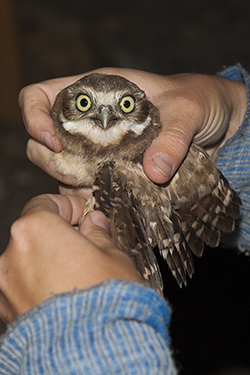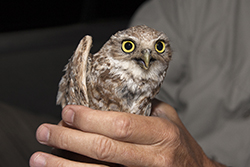

A dwindling population of a tiny owl in Southern California has a chance at a comeback, thanks to a collaborative effort by scientists from CDFW, the San Diego Zoo’s Institute for Conservation Research (ICR), Caltrans and the U.S. Fish and Wildlife Service.
The Western burrowing owl (Athene cunicularia hypugaea) is currently listed as a Species of Special Concern, and nongame scientists have long been concerned about their viability and survival. Breeding populations have especially declined in the central and southern coastal areas, due in large part to a combination of habitat loss and eradication of the ground squirrels that dig out the burrows where the owls make their nests. In San Diego County specifically, the once-widespread population has been reduced to a single breeding node in the Otay Mesa region, just north of the Mexico border.
Two groups in particular have been monitoring these owls carefully, in an effort to help. Biologists from Zoo’s ICR have spent seven years assessing owl population status and productivity, including assessing the feasibility and effectiveness of artificial burrows, refining techniques to help the ground squirrels thrive and disperse into new areas and developing a system of identifying potential new locations where the owls might thrive. Much of ICR’s owl research has been conducted at Brown Field, a small municipal airport near the border within the City of San Diego, and on an adjacent property owned by Caltrans.
Meanwhile, about 10 miles from the Brown Field study site, CDFW scientists have spent a decade working to create more suitable burrowing owl habitat at Rancho Jamul Ecological Reserve (RJER). Efforts there included installation of artificial burrows and mowing the tall grass to foster a low-growing grassland suitable for burrowing owls and ground squirrels. Despite their best efforts, CDFW scientists studying the Rancho Jamul site have experienced many years of disappointment -- although wintering owls have shown up every year, none have stayed and attempted to breed on the property. But conditions have been improving over the last four years, thanks to the implementation of a grazing program that reduced dense thatches of old grasses and expanded areas of open ground. As habitat changed at Rancho Jamul, CDFW scientists observed more squirrel burrows, and the conditions seemed just about right for the owls.
This spring, an approved development project at Brown Field began to take shape – and it became evident that the timing for an owl translocation project was ripe at last. Thanks to efforts by Caltrans, which incorporated burrowing owl habitat restoration as part of their mitigation effort for a nearby highway, CDFW staff believed the owl population to be strong enough to support a translocation effort. Also the spring season, just prior to egg-laying, is likely the optimum time to move the animals. After looking at many options, scientists decided to try to move five pairs of breeding owls to RJER in the hopes that they would establish a new population and thrive.
The full conservation team – which included CDFW, the U.S. Fish and Wildlife Service, the City of San Diego, Metro Air Park, Schaefer Ecological Solutions and the San Diego Zoo – was on board and ready to move the owls. In March 2018, the team caught five pairs and moved them to hacking cages at RJER. The owls lived in the cages for about one month to give them time to acclimate to their new surroundings. By the time the cages were removed, each female had laid at least one egg in the artificial burrow chamber.
CDFW Environmental Scientist Dave Mayer has worked on this project for years and is anxious to see efforts at RJER finally pay off. The presence of the eggs, he said, was thrilling to see. “More owls, and at diverse locations, is what it will take to conserve this species in San Diego County. This first step was a long time coming, but I have all my fingers crossed that it’s going to work.”
This successful multi-agency partnership will continue long past the actual translocation day. Scientists banded the owls and fitted some with radio transmitters. ICR staff will monitor the owls themselves, while CDFW staff will monitor the grassland and the grazing program, and perform inspections and repairs of the artificial burrows twice a year. After five years, CDFW will perform regular monitoring of the owls, the habitat and associated grazing practices, and the general status of the ground squirrel population.
Mayer is proud of the work achieved so far in this unusual project. “We built a better mousetrap, with the Zoo’s help,” he says.
General information about California’s bird species of special concern can be found on the CDFW website, along with the  species account (PDF) for the burrowing owl and information about Rancho Jamul Ecological Reserve.
species account (PDF) for the burrowing owl and information about Rancho Jamul Ecological Reserve.
The San Diego Zoo has also issued a  news release with more details about the burrowing owl translocation project.
news release with more details about the burrowing owl translocation project.
All photos © San Diego Zoo Global, all rights reserved
# # #